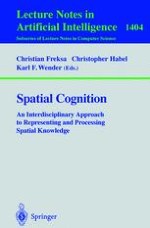1998 | OriginalPaper | Buchkapitel
The Route Direction Effect and its Constraints
verfasst von : Karin Schweizer, Theo Herrmann, Gabriele Janzen, Steffi Katz
Erschienen in: Spatial Cognition
Verlag: Springer Berlin Heidelberg
Enthalten in: Professional Book Archive
Aktivieren Sie unsere intelligente Suche, um passende Fachinhalte oder Patente zu finden.
Wählen Sie Textabschnitte aus um mit Künstlicher Intelligenz passenden Patente zu finden. powered by
Markieren Sie Textabschnitte, um KI-gestützt weitere passende Inhalte zu finden. powered by
The route direction effect can be characterized as follows: When a person has learned a route and imagines that he or she is at a specific point along this route, then it is easier for him or her to imagine him or her-self at another point on the route which lies in the direction in which the route was learned than the other way around. This means that route knowledge includes information on the route if acquisition, i.e. the direction of acquisition is co-represented in cognitive maps. Within a network theory approach, the route direction effect can be conceived of as a specific asymmetry in the spread of activation. Priming-experiments were carried out to determine a time window for the experimental realization of asymmetrical activation spread. We were actually able to show that the route direction effect disappears when the Stimulus Onset Asynchrony is extended. This was to be expected because a longer SOA causes the target to be pre-activated, regardless of whether it represents an object which was positioned in the direction of acquisition, or not. In further experiments we showed that if route knowledge is gained via a gradient sequence, then normal ecological conditions of perception must have existed: The direction of perception must correspond to the direction of movement. Objects, as well as their surroundings, must be perceived within the normal optical flow. Otherwise the information about the direction of acquisition cannot be adequately incorporated, and the route direction effect does not occur.
